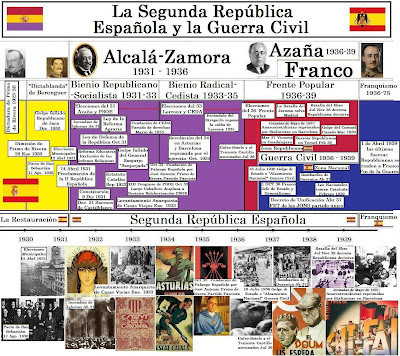-Se organizarán grupos de trabajo para la confección de una herramienta historiográfica de importancia capital: el Eje Cronológico.
-Cada grupo deberá trasladar a una cartulina mural cada uno de los ejes propuestos por el profesor. Los contenidos textuales pueden imprimirse desde un procesador de textos y las imágenes ilustrativas pueden ser obtenidas en Internet. Se espera que el grupo respete las proporciones y la escala del eje propuesto.
-La calificación del trabajo se compartirá entre los miembros del grupo y constituirá el 20 % de la nota de la primera evaluación.
-Los integrantes de cada grupo se repartirán equitativamente el trabajo en funciones y tiempo: redacción e impresión de los contenidos textuales, trazado de las líneas y ejes, coloreado de las franjas etcétera. Se invita a poner en conocimiento del profesor aquellas situaciones en las que no se comparta el peso y las responsabilidades del trabajo de forma justa.
-La fecha límite de entrega de los trabajos será el 9 de diciembre de 2011.
-4ºESO C: Los trabajos se repartirán en 4 grupos de 3 personas, 2 grupos de 2 y 3 trabajos individuales en función de las dimensiones y contenidos del eje.
-Cada grupo deberá trasladar a una cartulina mural cada uno de los ejes propuestos por el profesor. Los contenidos textuales pueden imprimirse desde un procesador de textos y las imágenes ilustrativas pueden ser obtenidas en Internet. Se espera que el grupo respete las proporciones y la escala del eje propuesto.
-La calificación del trabajo se compartirá entre los miembros del grupo y constituirá el 20 % de la nota de la primera evaluación.
-Los integrantes de cada grupo se repartirán equitativamente el trabajo en funciones y tiempo: redacción e impresión de los contenidos textuales, trazado de las líneas y ejes, coloreado de las franjas etcétera. Se invita a poner en conocimiento del profesor aquellas situaciones en las que no se comparta el peso y las responsabilidades del trabajo de forma justa.
-La fecha límite de entrega de los trabajos será el 9 de diciembre de 2011.
-4ºESO C: Los trabajos se repartirán en 4 grupos de 3 personas, 2 grupos de 2 y 3 trabajos individuales en función de las dimensiones y contenidos del eje.
Haz click sobre 4ºC.
2-LA ESPAÑA DEL SIGLO XVIII- CARLOS III Y CARLOS IV 3 PAX
3-LA REVOLUCIÓN FRANCESA 3 PAX
4-LA FRANCIA NAPOLEÓNICA 3 PAX
5- PERSONALIDADES DE LA REVOLUCIÓN FRANCESA Y LA FRANCIA NAPOLEÓNICA 1 PA
6- PARTIDOS POLÍTICOS DE LA REVOLUCIÓN FRANCESA + SÍMBOLOS DE FRANCIA 1 PA
7- LAS UNIFICACIONES DE ITALIA Y ALEMANIA 1 PA
8-PERSONALIDADES DE LA INDEPENDENCIA EE UU 2 PA
9-SEPARACIÓN DE PODERES EN EE UU 2 PAX
-4ºESO B: Los trabajos se repartirán en 4 grupos de 4 personas, 4 grupos de 2 y otro individual en función de las dimensiones y contenidos del eje cronológico.
Haz click sobre 4ºB.
1- THE 18TH CENTURY SPAIN – FELIPE V+FERNANDO VI 4 PAX
2-THE 18TH CENTURY SPAIN – CARLOS III+CARLOS IV 4 PAX
3-FRENCH REVOLUTION 4 PAX
4-NAPOLEONIC FRANCE 4 PAX
5- POLITICAL PARTIES OF THE FRENCH REVOLUTION + SYMBOLS OF FRANCE 2 PAX
6- THE UNIFICATIONS OF ITALY AND GERMANY. 2 PAX
7- LEADING FIGURES OF THE INDEPENDENCE OF THE USA 2 PAX
8- CHECKS AND BALANCES IN THE USA 2 PAX
9- LEADING FIGURES OF THE FRENCH REVOLUTION AND THE NAPOLEONIC FRANCE 1 PAX
2-THE 18TH CENTURY SPAIN – CARLOS III+CARLOS IV 4 PAX
3-FRENCH REVOLUTION 4 PAX
4-NAPOLEONIC FRANCE 4 PAX
5- POLITICAL PARTIES OF THE FRENCH REVOLUTION + SYMBOLS OF FRANCE 2 PAX
6- THE UNIFICATIONS OF ITALY AND GERMANY. 2 PAX
7- LEADING FIGURES OF THE INDEPENDENCE OF THE USA 2 PAX
8- CHECKS AND BALANCES IN THE USA 2 PAX
9- LEADING FIGURES OF THE FRENCH REVOLUTION AND THE NAPOLEONIC FRANCE 1 PAX




























